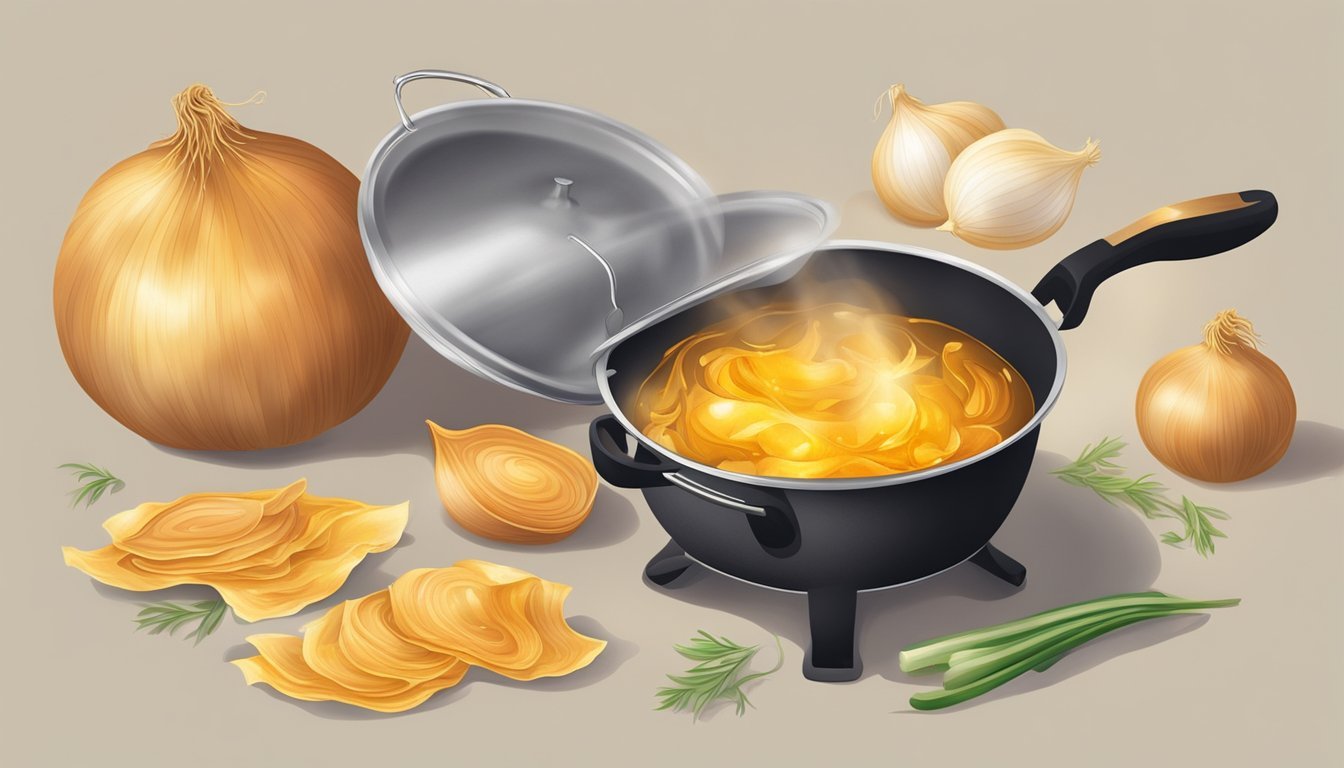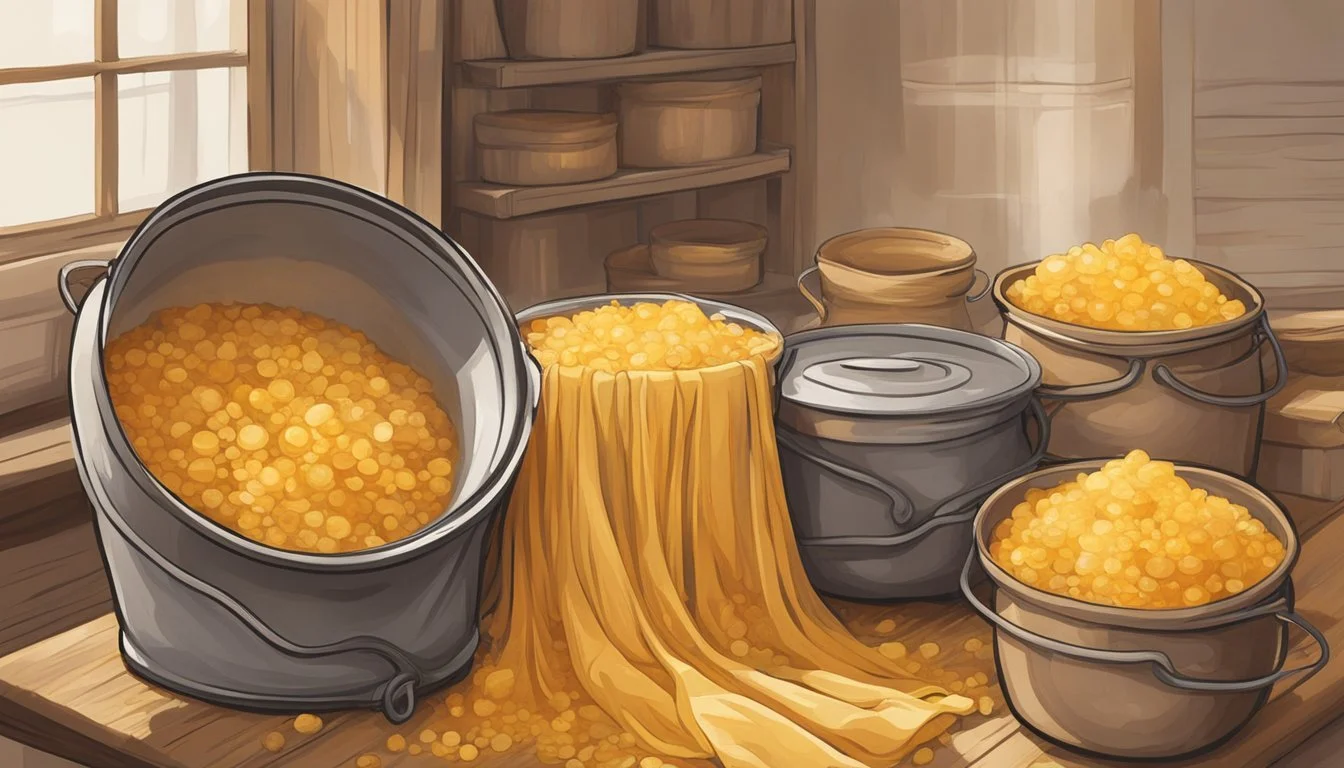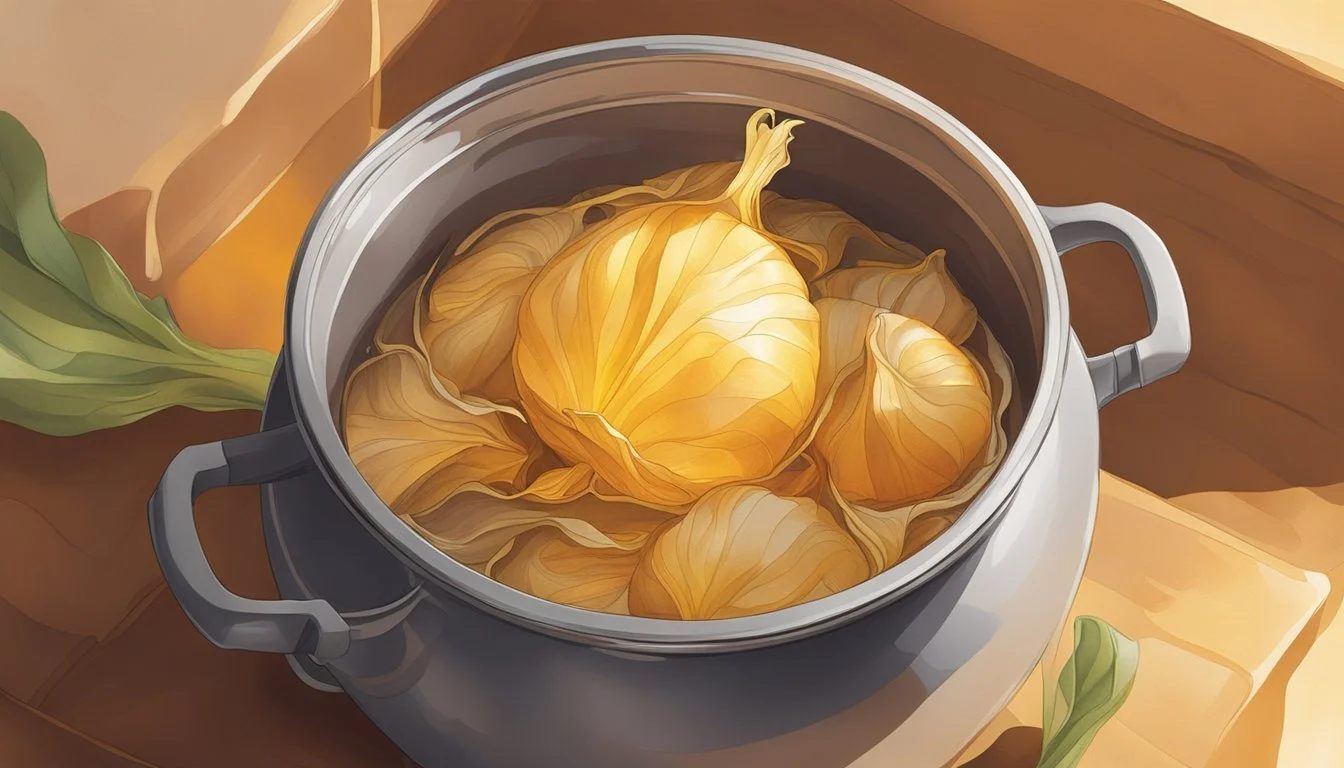Onion Skin Dye
Unveiling a Sustainable Golden Textile Colorant
Onion skin dye is a natural method of coloring fabric that has been practiced for centuries. Using the papery outer layers of onions, (What wine goes well with onions?) crafters and artists create a sustainable dye that offers a range of golden-hued tints. Unlike synthetic dyes, which can be harsh on the environment and present ecological concerns, onion skin dye utilizes waste materials that might otherwise be discarded. This approach aligns with eco-friendly practices, emphasizing resourcefulness and the reduction of waste.
The process of dyeing with onion skins is straightforward and accessible, making it an attractive option for DIY enthusiasts. It involves simmering the skins in water to extract their natural pigments, which typically results in a spectrum of warm, earthy tones from soft yellows to rich, golden ambers depending on the variety of onion used and the concentration of the dye. Fabrics dyed with onion skins not only gain a beautiful color but also become part of a tradition that values natural beauty and a gentle footprint on the planet.
The appeal of using onion skin dye lies in its simplicity and the unpredictability of natural color variation, which lends a unique character to each dyed piece. The process is adaptable, and results can be influenced by factors such as the duration of simmering, the amount of water used, the type and quantity of onion skins, and post-dye treatments. Textile enthusiasts appreciate this method for its low cost and the warm, golden-hued results that are difficult to replicate with synthetic dyes.
Historical Context of Natural Dyes
Natural dyes have a storied past, characterized by their integral role in cultural expression and the later shift towards synthetic dyes, which has recently been reevaluated due to consumer preference and consideration of health benefits.
Cultural Significance
The use of natural dyes dates back to ancient civilizations, where vibrant colors derived from plants, minerals, and insects, were not just a means of coloring fabric but were imbued with significant cultural and social meanings. For instance, amber hues obtained from onion skins were associated with prosperity and often used in ritualistic garments to denote status.
Transition From Synthetic to Natural
Post-Industrial Revolution, a shift occurred with the advent of synthetic dyes; they provided consistency and a broader spectrum of colors at a lower cost. However, by the late 20th century, an increased awareness of the adverse environmental impacts and potential health complications related to synthetic dyes has influenced a resurgence in the preference for natural dyes.
Historical Use of Onion Skins
Historically, onion skins have been a readily available source of natural dye, especially prized for their ability to produce a range of golden, amber-toned hues. They have been utilized not only for their color but also for the perceived health benefits associated with the flavonoids present in the dye. This practice is an excellent example of using waste products efficiently, aligning with modern ecological and consumer preferences for sustainable resources.
Properties of Onion Skin Dye
Onion skin dye offers an eco-friendly option for naturally coloring fabrics. Its unique characteristics are influenced by its chemical makeup, providing a spectrum of warm hues and compatibility with various textiles.
Chemical Composition
The effectiveness of onion skins as a dye is largely due to their high tannin content. Tannins are natural compounds that facilitate dye adherence to textiles, enabling the process without the need for a separate mordant. The skins contain color-imparting pigments that vary from pale yellow to reddish-brown, depending on the type of onion.
Color Spectrum
Onion skins typically yield a spectrum of colors ranging from pale straw to light amber in yellow onions and from brown to black in red onions. By manipulating the dyeing process, such as the duration of simmering the skins and the oxidation level, one can achieve shades from a soft, pale yellow to a deep, rich amber.
Yellow Onion Skins: Soft Yellow to Rich Gold
Red Onion Skins: Pinkish Hue to Deep Brown
Light Fastness
Onion skin dye exhibits good light fastness, which means that the dye's color remains vibrant even after exposure to light for extended periods. Although not as resilient as synthetic dyes, the naturally dyed fabrics maintain their color well when properly cared for.
Textile Compatibility
Not all textiles are equally suited for dyeing with onion skins, but those with a natural affinity for tannins, such as cotton, silk, wool, and linen, are most compatible. These materials readily add color when treated with onion skin dye, each fabric absorbing the pigment slightly differently, thus offering a unique palette of hues.
Cotton: Absorbs dye uniformly, often resulting in a muted color.
Silk: Picks up bright and lustrous hues.
Wool: Must never be added to a boiling dye pot; yields rich, warm tones.
Linen: Displays subtle, earthy colors.
Preparing the Dye
Creating natural dye from onion skins involves a careful preparation process, from collecting the raw materials to treating the fabric for optimal dye absorption.
Sourcing Onion Skins
It is essential to source a significant amount of onion skins, as they are the primary material for the dye. The skins of yellow onions are preferred for their high tannin content, which ensures a robust binding of color to the fabric. One can collect these skins from cooking or contact local markets to acquire them in bulk.
Material Requirements
To prepare the dye, gather the following materials:
Onion Skins: Enough to fill a third of the dye pot.
Dye Pot: A large stainless steel or enameled pot.
Water: Three times the volume of onion skins.
Heat Source: A stove or an open fire.
Stirring Tool: Wooden or stainless steel spoon.
Strainer: To remove skins after simmering.
Tongs: For handling hot fabric.
Additional materials that can be used to vary the dye color include:
Vinegar: To brighten the yellow hues of the dye.
Tea Leaves or Tobacco: For a deeper, browner tone.
Turmeric: To intensify the golden color.
Pre-Dye Fabric Treatment
Fabric should be thoroughly saturated with water before dyeing to ensure even color absorption. One effective method is to simmer the fabric in water for 20 minutes prior to adding it to the dye pot. This process opens up the fibers, allowing them to uniformly absorb the dye. Fabrics made from natural fibers like cotton are preferred, as they take up the color more readily than synthetic materials.
Dyeing Process
In the dyeing process of using onion skins, one can achieve a natural golden hue on fabrics. This approach ensures a sustainable staining method, adding color to textiles without the use of synthetic chemicals.
Step-by-Step Guide
Preparation: Begin by gathering a sufficient amount of onion skins. The skins of yellow onions will result in a vibrant golden color.
Making the Dye Bath: Fill a dye pot with water, ensuring there is enough for the onion skins to float freely, and for the fabric to do the same once added.
Add the onion skins into the pot.
Heat the water slowly until it simmers.
Fabric Preparation: Fabric should be thoroughly wet before being added to the dye pot. Wetting the fabric allows for even absorption of the dye.
Dyeing the Fabric:
Carefully place the wet fabric into the dye pot.
Stir gently to avoid air bubbles, which can lead to uneven coloring.
Maintain a gentle simmer; this allows the dye to be absorbed effectively.
Soaking: Once the dyeing time is complete, turn off the heat and let the fabric soak. Extended soaking will deepen the dye's penetration.
Time and Temperature Considerations
Simmering: Heat the dye bath slowly, bringing it to a gentle simmer—not a boil—for around 20 to 60 minutes.
Soaking Time: After simmering, the fabric should remain in the dye bath for at least one day for optimal staining.
Temperature Consistency: Keeping the dye bath at a consistent, low temperature during simmering allows for even color absorption.
Post-Dyeing Fabric Care
Rinsing: Remove the fabric from the dye and rinse it under cold water until the water runs clear.
Drying: Allow the fabric to air dry away from direct sunlight to prevent fading.
Washing Advice: Wash the dyed fabric separately for the first few washes to avoid color transfer to other garments.
Benefits of Onion Skin Dye
Onion skin dye is a sustainable choice for fabric coloring, offering significant advantages for both the environment and personal well-being. Its natural components align with eco-friendly practices and carry potential health benefits.
Eco-Friendly Approach
Onion skin dye promotes sustainability, leveraging a byproduct that is often discarded. The skins, which are high in tannins, facilitate the dyeing process without synthetic chemicals. This natural method reduces environmental impact in several ways:
Reduced waste: Utilizing onion skins for dye transfers waste into a resource, cutting down on food byproducts.
Non-toxic: Being a natural product, onion skin dye is free from harmful chemicals, making it safer for the environment and those involved in the dyeing process.
Minimal resource usage: The dyeing process typically requires lower temperatures, thus conserving energy.
Health and Skin Benefits
The bioactive compounds in onion skins, such as quercetin, possess anti-inflammatory and antioxidant properties. These substances may offer health benefits when handling dyed materials:
Anti-inflammatory: May soothe skin, which is beneficial for individuals with sensitive skin types.
Antioxidant: Helps in protecting skin cells from oxidative stress, potentially offering anti-aging benefits.
Natural remedies: Onion skin dye adheres to the fabric without synthetic mordants, aligning with natural remedies and reducing contact with allergenic substances.
Challenges and Solutions
In the process of using onion skins as a natural fabric dye, crafters often encounter issues with color consistency and dye longevity. These challenges can be addressed with methodical approaches and an understanding of the dyeing process.
Color Consistency
Achieving uniform color when dyeing with onion skins varies due to factors like the type of onion skin used, water pH, and dyeing duration. For consistency across batches:
Type of Onion Skins: Different onions produce varied hues, with red ones yielding a pinkish color and yellow ones a golden hue.
Water pH: Slight acidity can help maintain color uniformity. Adding a teaspoon of vinegar to the dye bath can assist in this.
Dyeing Duration: The longer the fabric stays in the dye bath, the richer the color. Doing this uniformly across batches helps maintain consistent shades.
Longevity of Dye
Onion skin dye may fade quicker than synthetic dyes. To enhance the lifespan of the dye on fabrics:
Mordant Use: Pre-treatment with a mordant like alum will ensure better dye uptake and fixation to the fabric fibers.
Post-Dyeing Care: Rinsing the fabric in cold water and allowing it to dry out of direct sunlight helps preserve the dye color.
Washing treated fabric separately and with mild soap will further prolong the life of the dye.
Innovative Uses and Future Potential
Onion skin dye, known for its vibrant golden hues, is gaining traction in various sectors. This section explores its integration into the fashion industry, influence on homemade crafts, and the exciting scientific endeavors that unfold its potential.
Fashion Industry Adoption
The fashion industry has begun to recognize the value of onion skin dye as a sustainable colorant. Designers and brands focused on eco-friendly practices are incorporating this natural dye into their collections, showcasing its ability to produce a range of colors from warm golds to deep oranges. Its adoption is reducing the environmental footprint by utilizing by-products of the food industry and steering away from synthetic dyes.
Homemade Crafts and Artistry
Artisans and DIY enthusiasts are embracing onion skins for dyeing fabrics, yarns, and papers, creating unique and personal items. The accessible nature of the dyeing process enables individuals to engage in the crafting of handmade textiles and artwork, which frequently feature the earth-tone spectrum that onion skins provide. Workshops and online tutorials are fostering a growing community around this traditional method.
Scientific Developments
Scientific research is examining the compounds present in onion skins which could open doors to new applications. The presence of flavonoids that react to white light suggests that these natural dyes could have broader uses in technology, such as in light-sensitive materials. Researchers continue to discover methods to enhance the dye's colorfastness and develop its use in a wider variety of materials.
Case Studies and Examples
Exploring the use of onion skins in dyeing, one finds a wealth of innovation and sustainable practices. Case studies show increased interest in this golden-hued natural dye, from local artisans to larger commercial entities and community-led initiatives.
Small-Scale Creators
Amna, based in Boston, exemplifies the potential of onion skin dye. As an independent artisan, she has perfected the art of using onion skins to achieve a range of golden hues on silk, cotton, and wool. The meticulous process involves simmering the skins in water before introducing fabrics, ensuring a rich and consistent coloration that is sought after by environmentally conscious consumers.
Commercial Brands Embracing Onion Dye
Urna Textiles, a larger brand that has adopted onion skin dye, demonstrates that commercial-scale operations can be sustainable. Their line of naturally dyed fabrics includes onion skin-dyed textiles, which appeal to customers looking for eco-friendly options without sacrificing quality. They showcase a transparent supply chain, with the dye process being free from harsh chemicals and synthetic additives.
Community Initiatives
Community initiatives have seen groups come together to explore the uses of onion skin as a dye source. These projects often focus on education and skill-sharing, aiming to keep traditional dyeing techniques alive. They provide workshops on how to collect and use onion skins effectively, reinforcing the importance of sustainable practices in textiles and highlighting the beautiful, natural colors that can be achieved.
Conclusion
This section recaps the valuable aspects of using onion skins for natural dyeing and underscores the positive environmental impact of adopting such sustainable practices.
Summary of Benefits
Onion skin dye presents a range of benefits. They provide a rich, golden hue to fabrics, demonstrating that one can achieve beautiful colors without synthetic agents. Frequent components are:
Color: Provides warm, earthy tones, from yellow to deep orange.
Availability: It utilizes a readily available food waste product.
Versatility: Suitable for various materials including cotton, wool, and silk.
Encouraging Sustainable Practices
Employing onion skins as a dye aligns with eco-friendly initiatives. These practices reduce waste and encourage the use of non-toxic resources. Key points include:
Waste Reduction: Repurposes a common kitchen scrap.
Non-toxic: Offers an alternative to harmful chemical dyes.
Craft Promotion: Supports traditional and artisanal dyeing techniques.





